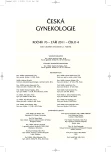Fetal tricuspid regurgitation
Authors:
J. Pavlíček 1; T. Gruszka 1; D. Matura 2; M. Pětroš 2; L. Jabůrek 3
Authors‘ workplace:
Oddělení dětské a prenatální kardiologie FN Ostrava, primář MUDr. T. Gruszka
1; Porodnicko-gynekologická klinika FN Ostrava, přednosta MUDr. O. Šimetka, Ph. D.
2; Porodnicko-gynekologická klinika FN a LF UP Olomouc, přednosta doc. MUDr. R. Pilka, Ph. D.
3
Published in:
Ceska Gynekol 2011; 76(4): 306-315
Overview
Aims:
To study the incidence and significance of fetal tricuspid insufficiency (TI). Evaluation of this incidence of physiological fetuses and of fetuses with congenital heart defects (CHDs). Possibility of prediction the other significant heart pathology or pathology of fetal circulation of fetuses with tricuspid regurgitation (TR).
Methodology:
The study was undertaken between June 2006 and 2010. Fetal echocardiography in the Moravian-Silesian region was mostly performed as a primary screening in the second term of pregnancy. The diameters of the right side of the heart (tricuspid valve annulus, pulmonary valve annulus, surface of the right atrium and diastolic size of the right ventricle) of fetuses with and without TI were evaluated. The pathology of the pregnancy was generally examined and delivery of the newborn was planned. The fetuses with TI were monitored and examined after delivery.
Results:
In the observed period, 8 896 pregnancies were examined and we diagnosed 90 significant CHDs. TR occurred in 178 (2%) fetuses. Out of them 20 (11%) fetuses had a defined CHD or significant heart arrhythmia. The most critical CHD with TR was hypoplastic left heart syndrome. TI was insignificant in 158 (89%) fetuses. Progression of the significance of TR with the color Doppler mapping correlated with increased speed of flow. The parameters of the right side of the heart of fetuses with TI do not significantly differ from that of fetuses with a normal tricuspid valve. After the delivery of fetuses with TI, no CHD or chromosomal aberrations were confirmed.
Conclusions:
The detection of fetal TI during pregnancy is possible. In some fetuses, there is TI connected with some other CHDs which might be detected by fetal echocardiography what provides us detailed description and diagnosis. TI was always insignificant after a CHD had been eliminated and this TR in the fetus did not significantly affect haemodynamics and did not predict any pathology.
Key words:
congenital heart defect, fetal echocardiography, tricuspid regurgitation.
Sources
1. Aslam, M., Christou, HA. Intrauterine closure of the ductus arteriosus: implications for the neonatologist. Am J Perinatol, 2009, 26, 7, p. 473-478.
2. Faiola, S., Tsoi, E., Huggon, IC., et al. Likelihood ratio for trisomy 21 in fetuses with tricuspidal regurgitation at the 11 to 13 + 6-week scan. Ultrasound Obstet Gynecol, 2005, 26, 1, p. 22-27.
3. Geipel, A., Willruth, A., Vieten, J., et al. Nuchal fold thickness, nasal bone absence or hypoplasia, ductus venosus reversed flow and tricuspid valve regurgitation in screening for trisomies 21, 18 and 13 in the early second trimester. Ultrasound Obstet Gynecol, 2010, 35, 5, p. 535-539.
4. Gembruch, U., Smrcek, JM. The prevalence and clinical significance of tricuspid valve regurgitation in normally grown fetuses and those with intrauterine growth retardation. Ulrasound Obstet Gynecol, 1997, 9, 6, p. 374-382.
5. Hornberger, LK., Sahn, DJ., Kleinman, CS., et al. Tricuspid valve disease with significant tricuspid insufficiency in the fetus: diagnosis and outcome. J Am Coll Cardiol, 1991, 17, 1, p. 167‑173.
6. Huggon, IC., Defigueiredo, DB., Allan, LD. Tricuspid regurgitation in the diagnosis of chromosomal anomalies in the fetus at 11-14 weeks of gestation. Heart, 2003, 89, p. 1071-1073.
7. Chaloupecký, V., et al. Dětská kardiologie. Praha: Galén, 2006, s. 265-270.
8. Iacobelli, R., Pasquini, L., Toscano, A., et al. Role of tricuspid regurgitation in fetal echocardiograhic diagnosis of pulmonary atresia with intact ventricular septum. Ultrasound Obstet Gynecol, 2008, 32, 1, p. 31-35.
9. Long, WE., Wilson, AD., Srinivasan, S., et al. In utero premature closure of the ductus arteriosus presenting as isolated right ventricular hypertrophy. WMJ, 2009, 108, 7, p. 370-372.
10. Marek, J. Pediatrická a prenatální echokardiografie. Praha: Triton, 2003, s. 57-77.
11. Mendl, V., Biolek, J., Jehlička, P. Případ těžkého fetálního hydropsu na podkladě idiopatického interauterinního uzávěru tepenné dučeje. Čs Pediat, 1999, 5, s. 208-210.
12. Nathan, AT., Marino, BS., Dominguez, T., et al. Tricuspid valve dysplasia with severe tricuspid regurgitation: Fetal pulmonary artery size predicts lung viability in the presence of small lung volumes. Fetal Diagn Ther, 2010, 27, p. 101-105.
13 Oberhoffer, R., Cook, AC., Lang, D., et al. Correlation between echocardiographic and morphological investigations of lesions of the tricuspid valve diagnosed during fetal life. Br Heart J, 1992, 68, 6, p. 580-585.
14. R Development core team (2010). R: A language and environment for statistical computing. R Foundation for Statistical Computing. Vienna, Austria.
15. Respondek, ML. Specific and nonspecific fetal cardiac problems. Pol Merkur Lekarski, 2004, 16, 25, p. 415-419.
16. Respondek, ML., Kammermeier, M., Ludomirsky, A., et al. The prevalence and clinical significance of fetal tricuspid valve regurgitation with normal heart anatomy. Am J Obstet Gynecol, 1994, 171, 5, p. 1265-1270.
17. Salvin, JW., McElhinney, DB., Colan, SD., et al. Fetal tricuspid valve size and growth as predictors of outcome in pulmonary atresia with intact ventricular septum. Pediatrics, 2006, 118, 2, e415-e420.
18. Sharland, GK., Chitta, SK., Allan, LD. Tricuspid valve dysplasia or displacement in intrauterine life. J Am Coll Cardiol, 1991, 17, 4, p. 944-949.
19. Shima, Y., Ishikawa, H., Matsumura, Y., et al. Idiopathic severe constriction of the fetal ductus arteriosus: a possible underestimated pathophysiology. Eur J Pediatr, 2011, 170, 2, p. 237-240.
Labels
Paediatric gynaecology Gynaecology and obstetrics Reproduction medicineArticle was published in
Czech Gynaecology

2011 Issue 4
Most read in this issue
- Fetal tricuspid regurgitation
- Application of SNP array method in prenatal diagnosis
- Transabdominal ultrasound examination in gynecology
- Current classification of malignant tumours in gynecological oncology – part I
